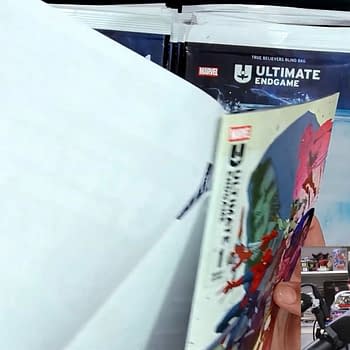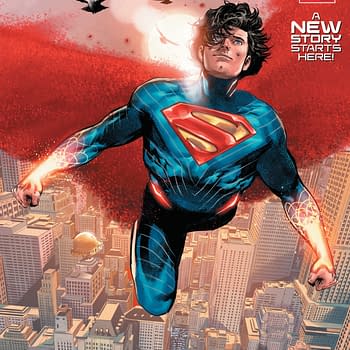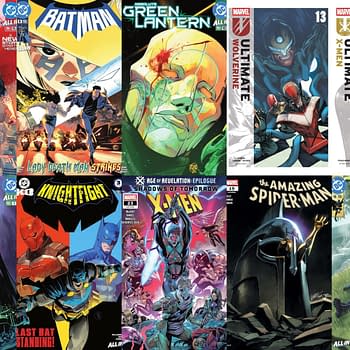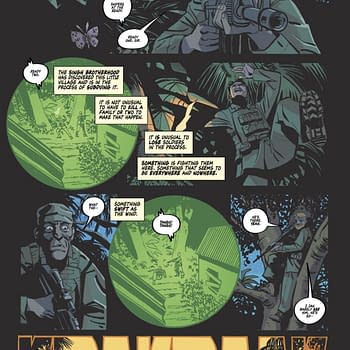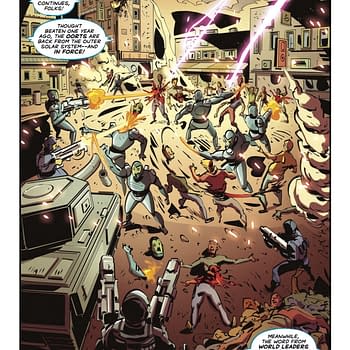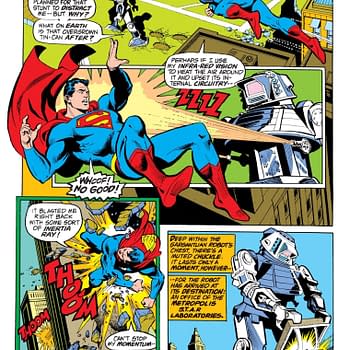Posted in: Comics | Tagged: Alan Moore, Kevin O'Neill, league of extraordinary gentlemen, loeg, lxg
FIRST REVIEW: League Of Extraordinary Gentlemen: Nemo Heart Of Ice

Alan Moore and Kevin O'Neill's League of Extraordinary Gentlemen has undergone something of an evolution over recent years. After the Victoriana-laced adventure-driven romps of volumes 1 and 2, the sequels Black Dossier and Century took the series' underpinning idea – the notion that all fictional characters could coexist within the same universe – and moved it to the foreground of the book, making the star of LOEG the concept rather than the characters and relegating the book's plots to a slightly more secondary concern. I don't think you'd struggle to make the case that the stories of the more recent books have worked in service of Moore's exploration of various ideas involving the nature of fiction and the evolution of literature over the past century, rather than the other way around.
Some readers have complained that this shift has robbed the book of some of its core appeal: the sheer enjoyment of seeing a group of various disparate literary characters team-up for an adventure story. Others, however, have appreciated the intellectual ideas being explored by the series, which have added depth and freshness to a book that could easily have grown stale if it had contented itself with endlessly repeating the formula of its first two volumes (you can guess which camp I fall into).
Well, detractors of LOEG's more recent outings will be overjoyed to discover that the latest adventure marks a return to a more straightforward, plot-driven style of storytelling.
Observant readers will notice that the title of this book has dropped the LOEG prefix altogether, and that's no accident, as the League don't really feature in this story at all. Instead, the book revolves around Janni Dakkar, the daughter of Captain Nemo, who (as readers of Century will remember) took over that role from her father after his death. It's a tale that sees Janni and her crew attempt to revisit an Antarctic expedition that once defeated Nemo, at the same time as she's pursued by agents of a certain publishing mogul whom she has manages to piss off royally (and I do mean royally) in the book's opening pages.
This setup provides a nice, tight chase structure to the story, ensuring that there's always a sense of pressure and momentum to drive things forward. And as the book goes on – and Janni starts to discover exactly why the previous expedition might have gone south, so to speak – there's a certain amount of dramatic tension created by seeing Janni and her crew encounter strange and unnatural locations and beings of which her pursuers are still unaware.
If it seems like I'm being a little vague, that's because I don't want to spoil the book's twists and turns – although informed readers can probably take a good guess at what reference points the literary world of LOEG would use for a story about a perilous early-20th-century trip to Antarctica which uncovers otherworldly and supernatural creatures. Still, even if you've got a rough idea of what Janni might be letting herself in for, it's fair to say that this book contains a few surprises that you won't see coming.
Because even a comparatively straightforward story like this one is enhanced by Moore's mastery of the medium, making use of the kind of tricks that only comics are capable of. My favourite technique that the book uses is probably the (intentionally) jarring sequence in which Janni and her crew suffer from a fractured perception of the passage of time. Panels appear out of sequence, are sometimes repeated, and frequently lack the connecting tissue that would be necessary for us to be able to make sense of what is transpiring in the story. Not only does this encourage us to empathise with the disorientation suffered by the characters, but it also stretches the mechanism through which comics come to life (that is, the reader being able to fill in the gaps between panels to create a flowing story) way past breaking point. Think Watchmen #4, but scarier and more unhinged.
My only real complaint with the book is that the characterisation is a little light – but that sentiment is probably largely due to the fact that Janni was one of my favourite 'new' characters in Century, and I was hoping to find out a little more about her than we do here. Having said that, however, the highly entertaining text passage at the back of the book (just like the ones found in each volume of Century) goes some way to filling in these gaps.
It's remiss of me to have got this far in my review without mentioning O'Neill's wonderful artwork – so let me remedy that straight away by telling you that this is some of my favourite work of his that I've seen. I've always had the impression that O'Neill is at his happiest when he can indulge his wilder and more imaginative streak (my favourite collaborations between him and Moore in recent years have been in the pages of Dodgem Logic magazine, which devoted a full page in each issue to a weird and wonderful O'Neill illustration) – and happily this book gives him plenty of opportunities to do that.
As well as the outlandish beings that we see towards the end of the book, there are all sorts of earlier opportunities for O'Neill to really impress – such as the splashpage that accompanies an impromptu stop-off for the Nautilus in Megapatagonia, or the slick redesign of Nemo's ship (that we also caught glimpses of in Century). In fact, the very first image of Janni and her crew is such a great shot that it makes me wish we could have seen the build-up to that moment play out – but then, the genius of O'Neill's illustration is that we don't need to, as everything that we need to understand the sequence of events that led up to that point is encoded into that single image.
And as ever, O'Neill fits so many little details and references into every panel that you just know that Jess Nevins will be busy for months. I probably only spotted a fraction of them (as usual), but fans of spot-the-reference will be pleased to learn that this book includes allusions to characters and stories as diverse as Popeye, Charles Foster Kane, The Thing, King Kong and H. Rider Haggard's She, as well as more than a sprinkling of HP Lovecraft (although still nothing here that's quite as gleefully fantastic as Black Dossier's mashup of Lovecraft and PG Wodehouse).
Even if LOEG's detractors have claimed that the cameos have become little more than an academic exercise of "Where's Wally?" – with characters appearing just because Moore and O'Neill want to shoehorn them into the world of LOEG, rather than because they serve a particularly useful purpose for the story – I still enjoy them, and if anything they're less conspicuous here than usual.
Before I wind up, I should make one final mention of this book's format, which marks a departure for the series in that it's a complete, self-contained 56-page hardcover rather than a serialised adventure (as with volumes 1 & 2 and Century) or a full-length graphic novel (as with Black Dossier). It's very much an adoption of the European album style, although still printed at the same page size as the previous League books. And it really works for the series, allowing Moore and O'Neill the chance to tell a tight, taut and focused story that's without any flab or filler. Hopefully we'll see future adventures in a similar format, as I think it's ideal for the book.
Frankly, though, I'm not too bothered what format we get LOEG comics in, as long as we keep getting more of them – and Nemo: Heart of Ice has convinced me that there's plenty of life left in the series, and an almost infinite number of directions in which it could proceed.
Nemo: Heart of Ice is published by Knockabout/Top Shelf and will be available from mid-February.






